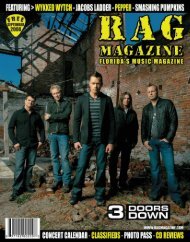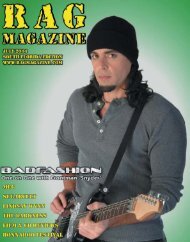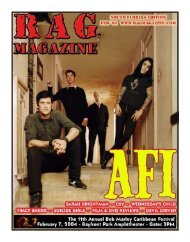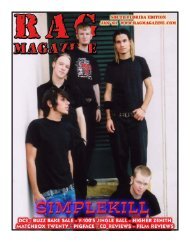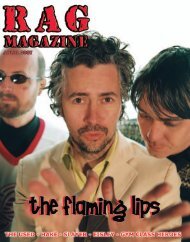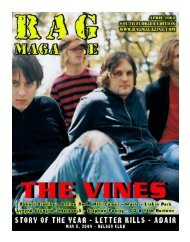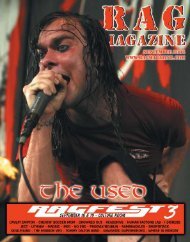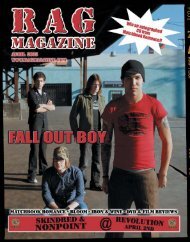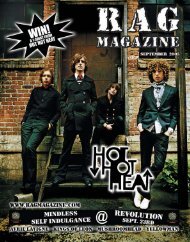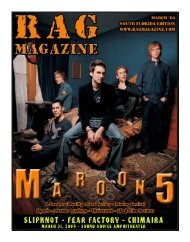VICTORIARUMMLERBy Pat Massard • Photos: Alexandre TomeAmerican Jazz in Paris is about as Parisian as, say, a croissant ata sidewalk café. Since the mid 1920s, American jazz musicianshave flocked here in droves, making their mark on the jazz world;Josephine Baker, Louis Armstrong, and Cole Porter all made thetrek to Paris and left an impact on the city that still exists today.The history and tradition run deep, each era producing its ownstyle, its own genre, and its own stars.While sitting at the Deux Magots Café, we meet with one of Paris’brightest new stars to hit the stage, recording artist, VictoriaRummler. Rummler is currently working on her second album,and was able to sit down with us for a few moments to discuss lifeand music in Paris. We arrived a few minutes early, and thusallowed ourselves to observe the full effect of her entrance: tall,blond, blue-eyed, and wearing a mixture of sparkle and fringe,Victoria brightened the room with her shy smile, yet she seemedfully oblivious to the heads she was turning.<strong>RAG</strong>: Hi, you do go by Vicki, correct?Hi and yes, Vicki’s fine. Actually I only became “Victoria” when Imoved to Paris. People here really love that name – and Vicki is adog’s name here! (laughs)<strong>RAG</strong>: Before we begin, we must admit, just sitting here inthis city is pretty amazing in itself.It definitely has its charms. (Laughs)<strong>RAG</strong>: So, where are you from, originally?I was born in Royal Oak, Michigan (outside Detroit), and grew upin Rochester, NY, Grand Rapids, MI, and Miami, FL. We moved alot because my Dad was with Kodak and was transferred everyfew years.<strong>RAG</strong>: It was in Miami that your musical ambitions began,correct?I guess so. I definitely obtained a lot of performance experiencewhile there. I went to Southwood Junior High and Palmetto HighSchool. I played in piano contests, toured Central America with theChristian show chorus Reach Out, and danced with the Palmetto“Chatonettes.” I’ll never forget when we were backstage at DisneyWorld and I saw a guy in a Mickey costume, but without the mask,smoking a cigarette and swearing about how he hated his job. It’sfunny now, but it really bummed me out at the time. With apologiesto Don Henley, I guess it was the end of the innocence. (Laughs)<strong>RAG</strong>: I assume your love of jazz emerged later; what wereyour early influences?My earliest memory is singing with my dad in the car; he taughtme how to hear and sing harmony, and also to appreciate differentlanguages, since we sang a song in German. I started pianolessons at age six and have always loved Chopin, Rachmaninoff,38| DEC <strong>RAG</strong> MAGAZINEand Debussy. In Miami, I started getting more serious about singing.Besides the church group, I also sang with the Omega Singers atPalmetto. We did some pretty hip stuff at the time – a Chicagomedley comes to mind, with some unforgettable choreography on“25 or 6 to 4” (laughs).In senior year, I sang with the stage band; we did a strange mixtureof Carpenters songs, disco and big band music. I rememberhearing Glenn Miller’s “In the Mood,” for the first time, and beingtotally blown away! I rushed home to let my parents hear it, and ofcourse, they had grown up with it and had a good laugh at myexpense! But the jazz seed was planted! I also directed andarranged for an a cappella group at Williams College. My favoritecontribution was the Doobie Brothers’, “What a Fool Believes.”<strong>RAG</strong>: What do you miss about Miami?I miss random things: sailing a Sunfish with Carlos on Saturdays,pep rallies at Palmetto High (not really - laughs) the Grove, theFalls, the smell of Mango trees, Godfather’s Pizza, the RustyPelican in Key Biscayne. And my modeling career, which startedand ended, with some work as an extra: on the second and thirdepisodes of Miami Vice!<strong>RAG</strong>: How did you get from Miami Vice to Williams College toParis?(Laughs) I had always wanted to go to college in New England -and Williams just felt right- so I applied and was accepted for earlyadmission. After graduating in 1988, I wanted something totallydifferent. I’d always been fascinated by foreign languages andcultures, so I took off for Munich, Germany. What was supposedto be six months turned into five years -working with BMG Records,and performing with a cabaret/performance art group in German.We did these wacky shows, using psychedelic slides and wearingvarious things on our heads: bathing caps, giant fluorescent piecesof fruit, blinking Eiffel towers (I kid you not). It was a premonition ofmy future in Paris!<strong>RAG</strong>: So you ended up in the Paris jazz world by way of Munich?Yes, pretty much. Again, it was time to shake it up a bit, take on anew challenge, and learn another culture. In 1993, I decided tofulfill a lifelong dream by spending a few months in Paris – and I’vebeen here ever since! I worked for MCA (now Universal) for almostfour years, and have been a freelance vocalist/composer/pianist/lyricist for ten years<strong>RAG</strong>: How does living and performing in France comparewith Germany? Is it as extreme as we would think?Well, Kind of. It’s hard to generalize, and it’s important to mentionthat Paris is like an island different from the rest of France (like NYin the US). But I often found the German lifestyle more similar tothe American: more organized, straightforward. In France, thingsseem more complicated, but also more creative. For example,when I worked for the record companies and would call someonein Germany, we would say our name instead of “hello,” get right tothe point, and the call would be over in three minutes. With the French,we would talk about the weather, the weekend, or something randomfor about fifteen minutes, and then get to the reason why we werecalling. It’s tricky, but fun figuring out how people work. And, it’s easierthan if I had moved to, say, Bangladesh! (laughs)<strong>RAG</strong>: I imagine “Jazz in Paris” has a better ring to it than“Jazz in Dhaka”?Can you imagine that? (laughs) My parents would have been thrilled!
<strong>RAG</strong>: Tell me about your music. Your style is very pure, andthe vocals are crystal clear; yet it all seems very unique. Howdid all of that come together?I did classical and pop, and yes disco, music growing up, but I’vebeen concentrating on jazz since I moved to Paris. The Americanjazz influence in Paris is huge, and it is kind of natural to continuethat. I’ve sung in a lot of vocal groups and have tried to remove allboundaries to what I can sing. As for my own style, it’s intricatelytied to my experiences in different US cities growing up, like Munichand Paris, the people I’ve met and things I’ve learned along theway. So it runs the gamut of emotions and genres. It can be playfulor powerful, structured or improvised. But more and more, it seemsto be a direct reflection of my own mood and experience at themoment. It’s a totally unique style I like to call “real time vocals.”drum. The reviews were great to read; they made me want to domore.<strong>RAG</strong>: How many originals were on that album? Do you writealone or do you have a writing partner?There are six originals out of eleven tunes. I’ve often writtenlyrics for other musicians, but so far, have always written musicalone. It’s something about keeping it as personal as possible;there’s also a part of me that feels really free and comfortablecreating alone. Once the basic tune is laid out, I sometimes askNico Morelli, the pianist I work with, for help with arranging –that is, finding the right context, structure, and instrumentation.But I do a lot of the arrangements myself too.<strong>RAG</strong>: Explain what you mean by “realtime”? It seems like an interesting takeon musical styles, especially jazz.It’s actually pretty hilarious using acomputer term to describe my style, givenmy intense love-hate relationship withcomputers! (laughs) It basically meansthat my singing is totally personal andfollows my moods. Also, the shows canbe really spontaneous, depending on theaudience or something that happensonstage – like one time there was ahorsefly that mysteriously attacked meduring a concert in a closed theater, so Ilaunched into an improvised solo basedon its buzzing!<strong>RAG</strong>: How do Parisian crowds differfrom, say, New York or Chicago?It’s funny, my solo jazz act debuted inFrance, so I was used to audiences notnecessarily knowing all the standards orunderstanding all the lyrics. So when I didmy first US tour in 2005, I was shocked,but thrilled that people hung on every word!It added a whole new dimension to how Icould communicate. For example, in DesMoines, I did a spontaneous version of“Georgia,” calling it “Iowa.” That show gota standing ovation!<strong>RAG</strong>: Your first album Twinkleopened to some great reviews, mostnotably your write-up in Jazz World.Tell me a bit about that.Twinkle was released on Pitch PuppyProductions in 2004. It was a presentationof my musical journey up until that point.There’s a wide selection of tunes, from thestandards, “I Could Write a Book,” and“They Can’t Take That Away,” to a tonguein-cheekoriginal called, “CocktailOptimism,” and a heartfelt ballad, “Words,”a cover of Pat Metheny’s “James,” and aJapanese traditional song called,“Watashi.” The instrumentation differsfrom one tune to the next, from piano, bass,drums/percussion to guitar and steelwww.<strong>RAG</strong>magazine.com | 39




